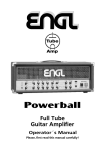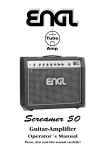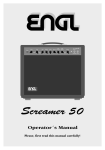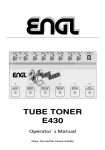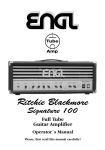Download Engl Full Tube Guitar Amplifier Operator`s manual
Transcript
Tube
Amp
Fireball
Full Tube
Guitar Amplifier
Operator´s Manual
Please, first read this manual carefully!
The
Fireball is dual channel, all-tube head that sets new standards for rock amps.
Boasting a totally new design, the head is equipped with a 6L6-loaded power amp (60 watts)
that packs a mighty punch and cranks out both cutting-edge hi-gain lead sounds and crisp
clean tone. Its vast gain reserves make the FIREBALL the king of the hill, the no. 1 rock amp
in the business. Delivering tight bottom end, smooth top end, and incredible sound pressure
levels, this amp puts into the hands of today's guitarists the sonic tools they need to carve
out highly defined, expressive tones of their own. Other trademark ENGL features include a
second master volume, electronic power amp monitoring, and a variable FX loop.
The
team is convinced that this amp will delight and inspire you.
FIREBALL - an amp that will rock your world!
Frontpanel
Input
Gain
Bass
Middle
Treble
Presence
Master A
Master B
Power Tube
Monitor
V1
Ultra
Gain
Bright Depth
V2
Tube
Amp
1
2
3 4
5
6
7
8
1 Input
9
10
11
12
13
Fireball
Stand By
Power
14
15
¼" unbalanced input. Plug your guitar cord in here.
2 Gain
This knob determines input sensitivity, in other words, the input level of the preamp. In Normal Gain
mode, it dials in the basic volume level and determines the amount of preamp saturation.
A tip from the designer:
The amount of distortion depends on the type of pickups your guitar is equipped with. Pickups with very
high output levels will overdrive the preamp when the knob is set to about the 12 o'clock position in
Normal Gain mode. This means that settings in the 12 to 5 o'clock range add varying levels of grit to the
signal, eliciting crunch sounds. When you have dialed in higher gain settings, you can clean up the sound
by simply backing off the volume knob of your guitar.
The amp's remarkably sensitive response to varying input levels lets you dial in a wast range of gain
levels in both Normal and Ultra Gain modes simply by working the guitar's volume knob.
CAUTION: Extremely high gain and volume levels in Ultra Gain mode can produce strong feedback.
Avoid feedback squeals, they lead to hearing loss and damaged speakers! Reduce the Gain, Treble
and Presence levels at higher volumes in order to avoid uncontrolled feedback!
3 Bright
Alters the EQ by boosting the upper treble range; effectiveness decreases at higher Gain settings;
the Bright feature affects both modes.
A tip from the designer:
For a crisp glassy tone, set the Bright switch to the On position.
This setting boosts the treble response of muddy pickups.
4 Depth
Alters the EQ by boosting the low end range; the Depth feature affects both Gain modes.
A tip from the designer:
When you're using a guitar equipped with bass-heavy pickups, you are well-advised to switch
this feature off to prevent it from muddying your tone, particularly at higher Gain settings.
5 Bass
Bottom end voicing control of the preamps´s passive EQ.
6 Middle
Mid-range voicing control of the preamp´s passive EQ.
7 Treble
Upper range voicing control of the preamp´s passive EQ.
8 Presence
This control shapes the Treble response in the power amp stage.
A TIP from the Designer:
To help you get acquainted with the amp's fundamental sounds, I recommend that you set all tone
controls to the center or 12 o'clock position. For ultra hi-gain sounds, your best bet is to turn the treble
and presence knobs well down to prevent the pickups and speakers from interacting at hi levels and
generating feedback (the recommended setting is somewhere in the 8 to 12 o'clock range). Since the
two knobs sweep through different frequency ranges and influence the signal at different places in the
amp's internal signal chain, you can dial in different combinations of treble and presence settings to
come up with many interesting sonic variations.
9 Ultra Gain
This button sets the preamp to Ultra Gain mode, which makes the amp's input stage extremely sensitive.
In this operating mode, the preamp is saturated at very low signal levels, which elicits a heavy lead sound
suitable for soloing or playing power chords.
You can also activate this function via a footswitch connected to jack 18. When a footswitch is plugged
in, the front panel Ultra Gain button is disabled. The red LED lights up to indicate Ultra Gain is active.
10 Master A - (Normal Gain)
Located after the effects loop in the signal chain, this knob determines the overall volume of the power
amp when Normal Gain preamp mode is selected. Note that this is a dedicated knob with a fixed
assignment to Normal Gain mode. However, when you connect a footswitch to jack 18, the knob is no
longer assigned exclusively to Normal Gain mode. This means that you can select the master A or the
master B volume knob via footswitch to activate two different master volumes for each mode. To learn
more about selecting modes and master levels, see section 18.
The red LED next to the knob lights up when this knob determines the master volume level.
11 Master B - (Ultra Gain)
Located after the effects loop in the signal chain, this knob determines the overall volume of the power
amp when Ultra Gain preamp mode is selected. Note that this is a dedicated knob with a fixed
assignment to Ultra Gain mode. However, when you connect a footswitch to jack 18, the knob is no
longer assigned exclusively to Ultra Gain mode. This means that you can select the master B or the
master A volume knob via footswitch to activate two different master volumes for each mode. To learn
more about selecting modes and master levels, see section 18.
The green LED next to the knob lights up when this knob determines the master volume level.
TIP from the Designer:
This option of using a footswitch to select the two master A and B knobs gives you another interesting
switching alternative: You can dial in two different volume levels and activate them in combination with
the amp's two operating modes. That gives you four basic sonic variations, each of which supports
different playing techniques: In effect, you get footswitchable clean (or slightly dirty) rhythm and lead
tones in normal mode, and overdriven preamp tones in Ultra Gain mode for power chords or distorted
lead guitar. And by working your guitar's volume knob, you can expand this palette of tones
accordingly.
12 POWER TUBE MONITOR V1
This LED lights up when the current sent through the V1 power amp tube was too high and the power
tube monitor system has switched that tube off.
13 POWER TUBE MONITOR V2
This LED lights up when the current sent through the V2 power amp tube was too high and the power
tube monitor system has switched that tube off.
A few words on the POWER TUBE MONITOR system:
The electronic power amp monitoring system constantly gauges the current sent to the two power amp
tubes. If it rises to too high a level, the system shuts down the given tube.
This can occur when the amp is operated incorrectly (for example, if the impedance is wrong due to an
incorrect speaker load), at extreme power spikes, or when a tube is defective.
Reset this electronic monitoring system by switching the standby switch on and off again. When you
press the standby switch to turn the amp on again, the system again measures the current sent to the
tube. If it is still too high, the power amp must be checked by a service technician, and the tube may
have to be replaced if it is defective.
14 Stand By
Power amp standby switch: Use this switch to silence (0 position) the amp when you take a lengthier
break. The amp's tubes stay warm, which means that it is ready to roll immediately when you switch it
back to full power. Note that for reasons of tube monitoring, the amp still receives a very low signal
level when standby is activated.
To reset the power tube monitoring circuitry, press the standby switch briefly (see Power Tube Monitor).
15 Power
AC power on/off.
Rear Panel
REPLACE FUSE
ONLY WITH SAME TYPE
AND RATING !
CAUTION !
!
R
DO NOT OPEN !
RISK OF ELECTRIC SHOCK !
DO NOT EXPOSE THIS EQUIPMENT
TO RAIN OR MOISTURE !
F.X.Loop
Footswitch
Poweramp Output
60 W All-tube Guitar Head Amp
Fireball
TYPE E625
designed by Horst Langer
MADE IN GERMANY
Ultra Gain
Master A/B
8
16 17
18
Or 16
And 16
Or->
16
Or
8
And 8
Dry Effect
Send
Return
Balance
19 20 21
8 Ohms Parallel
1 x 8 Ohms
2 x 16 Ohms
16 Ohms Serial
1 x 16 Ohms (Use Left Jack!)
2 x 8 Ohms
22 23 24 25
16 AC Socket
Connect an AC cord here.
CAUTION: Ensure you use an intact AC cord with an insulated plug only!
Before you power the amp up, ensure the voltage value printed beside the
AC socket corresponds to the available current.
17 AC Fuse Box
Contains mains fuse (rear chamber) and spare fuse (front chamber).
NOTE: Ensure replacement fuses bear identical ratings (refer to the table)!
18 Footswitch Ultra Gain; Master A - B
Stereo jack designed to take a dual footswitch for the following functions:
1. To switch back and forth between Normal Gain and Ultra Gain modes (mono terminal).
2. To switch back and forth between the master A and B knobs (stereo terminal)
Note that when you connect a footswitch to this jack, the master A/B switching option is reassigned to
the footswitch, allowing you to activate the volume level of each knob irrespective of mode (Normal or
Ultra Gain).
19 F.X. Loop Send
Signal output for the Effects loop. Connect this output to a signal processor’s
input/return jack via a shielded cable with 1/4" plugs.
20 F.X. Loop Return
Signal input for the Effects loop. Connect this input to a signal processor’s
output/send jack via a shielded cable with 1/4" plugs.
21 Balance
FX mix control for the Effects loop: Rotate the knob to the "DRY" position for the pure
amp signal, i.e. no effect on the signal. Turn clockwise to blend in an effect connected to the loop
to the dry signal (parallel/passive). At the "EFFECT" position, only the wet signal, i.e. the signal
sent from the FX device is fed to the power amp (serial/passive).
NOTE: If no effects processor is connected to this loop, leave this control in the "DRY" position!
22, 23 Poweramp Output 8 ohms parallel:
Parallel 8-ohm speaker outs, connected internally in parallel. Connect an 8-ohm cabinet here.
Alternatively, two 16-ohm cabinets can also be connected to these two outputs.
24 Poweramp Output 16 ohms serial:
16-ohm speaker out, connected internally in series with Jack 25. Connect a 16-ohm cabinet here. Two
8-ohm speakers are connected to Jacks 24 and 25.
CAUTION: If you intend to use a 16-ohm cabinet only, make absolutely certain you
connect it to Jack 24. Jack 25 is only enabled when a speaker is connected to jack 24.
25 Poweramp Output 16 ohms serial:
16 ohms serial. This is an auxiliary output connected in series with Jack 24. This jack is designed for one
application for only—when you are driving a combination of two 8-ohm cabinets/speakers. This output
may only be used when an 8-ohm speaker is connected to Jack 24. (See the example for Item 24)
NOTE: Never operate the amplifier without a sufficient load, otherwise you may damage or destroy
the power amp! Ensure your cabinet’s specifications match the respective output’s specs.
Possible speaker combinations:
1 x 8 ohms or 2 x 16 ohms (Jacks 22 and 23) or
1 x 16 ohms (Jack 24!) or 2 x 8 ohms (Jacks 24 and 25).
recommended cabinets (available in Standard and Vintage versions):
1 x 112": ENGL 112, 8 ohms connected to jack 22 or 23.
1 x 210": ENGL 210, 16 ohms, connected to jack 24.
1 x 212": ENGL 212, 16 ohms, connected to jack 24.
1 x 412": ENGL 412, slanted or straight, 8 ohms, connected to jack 22 or 23.
2 x 112": ENGL 112, 8 ohms (16 Ohm serial) connected to jack 24 and 25.
2 x 210": ENGL 210, 16 ohms (8 ohms parallel), connected to jack 22 and 23.
2 x 212": ENGL 212, 16 ohms (8 ohms parallel), connected to jack 22 and 23.
2 x 412": ENGL 412 slanted or straight, 8 ohms (16 Ohm serial), connected to jack 24 and 25.
Technical Data, Type 625 ("Fireball"):
Rated power:
Tubes:
approx. 60 watts at 8 or 16 ohms;
Poweramp:
Preamp:
V1, V2:
6L6GC matched set.
V3 (input tube): ECC 83 / 12AX7, FQ selected;
V4, V5:
ECC 83 / 12AX7 selected;
V6:
ECC 83 / 12AX7, standard;
Fuses:
external: 1 AT (slow) for the 230 V model;
2 AT (slow) in the 100 and 120 V models.
internal: 1,25 AT (slow) for the 230 V model;
2,5 AT (slow) in the 100 and 120 V model.
Important:
Replace fuses only with same type and rating!
Power
Consumption:
Dimensions:
Weight:
Tube Array:
160 watts
approx. 71 x 27 x 27 cm (l x h x d)
approx. 19 kg
Output
Transformer
V1
V3
V4
V5
V2
V6
Power
Transformer
REPLACE FUSE
ONLY WITH SAME TYPE
AND RATING !
CAUTION !
DO NOT OPEN !
RISK OF ELECTRIC SHOCK !
DO NOT EXPOSE THIS EQUIPMENT
TO RAIN OR MOISTURE !
F.X.Loop
Footswitch
!
R
Poweramp Output
60 W All-tube Guitar Head Amp
Fireball
TYPE E625
designed by Horst Langer
MADE IN GERMANY
Ultra Gain
Master A/B
8
Or 16
And 16
Or->
16
Or
8
And 8
Dry Effect
Send
Return
Balance
8 Ohms Parallel
1 x 8 Ohms
2 x 16 Ohms
16 Ohms Serial
1 x 16 Ohms (Use Left Jack!)
2 x 8 Ohms
or
2.
1.
MIDI SWITCHER
ifier
Tube Ampl
WRITE
ON/OFF
MIDI
CHANNEL
SWITCH
LOOP 1
SWITCH
LOOP 2
SWITCH
LOOP 3
SWITCH
LOOP 4
SWITCH
LOOP 5
SWITCH
LOOP 6
ON/OFF
Options for controlling the Fireball amp remotely:
1. Two-way footswitch (e.g. ENGL Z-4): Connect it to the amp (jack 18) via a stereo ¼" cord.
Functions: Normal - Ultra Gain, Master A - Master B.
2. MIDI-Switcher (e.g. ENGL Z-11): Connect the unit to the amp viaw stereo ¼" cords. The
buttons on the Switcher control Normal - Ultra Gain, Master A - Master B. If you program the
diverse switching configurations to different MIDI program locations (e.g. Ultra Gain & Master A,
or Normal & Master B, etc.), you can activate the desired configuration directly via a MIDI board
(e.g. ENGL Z-12). This type of control option is extremely versatile, we recommend it highly
if you intend to use the amp in conjunction with a MIDI system (e.g. MIDI effects devices).
Handling and Care
Protect the amp from mechanical knocks (tubes!).
Let the amp cool down before you transport it (approx. 10 minutes).
Tubes need about 20 seconds to warm up after you switch the power on,
and further few minutes before they reach their full power capability.
Avoid storing the amp in damp or dusty rooms, they are hard on jacks,
switches and potentiometers.
Make sure air can circulate at the front and top of the amp
to allow for adequate cooling (increases component life).
Never operate the amp without an adequate load.
Replace tubes with select
replacement tubes (special selection criteria)
to avoid microphonic properties, undesireable noise and unbalanced performance.
Attention! Please read the following!
This guitar amplifier can produce high volume levels.
Exposure to high volume levels may cause hearing damage!
Leave tube replacement and power amp biasing to qualified professionals.
Be sure the unit is switched off and unplugged!
Caution! Tubes can get very hot and burn skin when touched.
Always use high quality cables.
Never plug the amp into an ungrounded outlet!
Never bridge a defective fuse and be sure replacement fuses feature
identical ratings!
Pull the AC mains plug before replacing fuses!
Never open the chassis or attempt repairs on your own. Consult qualified
service personnel!
Never expose the amplifier to extreme humidity or dampness!
Please read the instructions carefully before operating the unit!
Be sure to operate and handle this amp as it was designed for. To this end,
please heed the instructions in the operator's manual.
You'll find an additional pamphlet accompanying this owner's
manual entitled "Instruction for the prevention of fire, electric shock
or injury of persons". Be sure to read it before you plug
the preamp in and switch it on!
ENGL Gerätebau GmbH, Germany;
internet: http\\www.engl-amps.com
Text, design, graphics, photography and layout by Horst Langer
We reserve the right to make unannounced technical upgrades!







